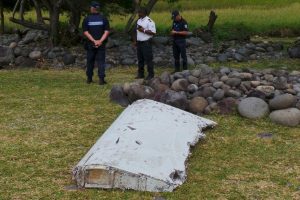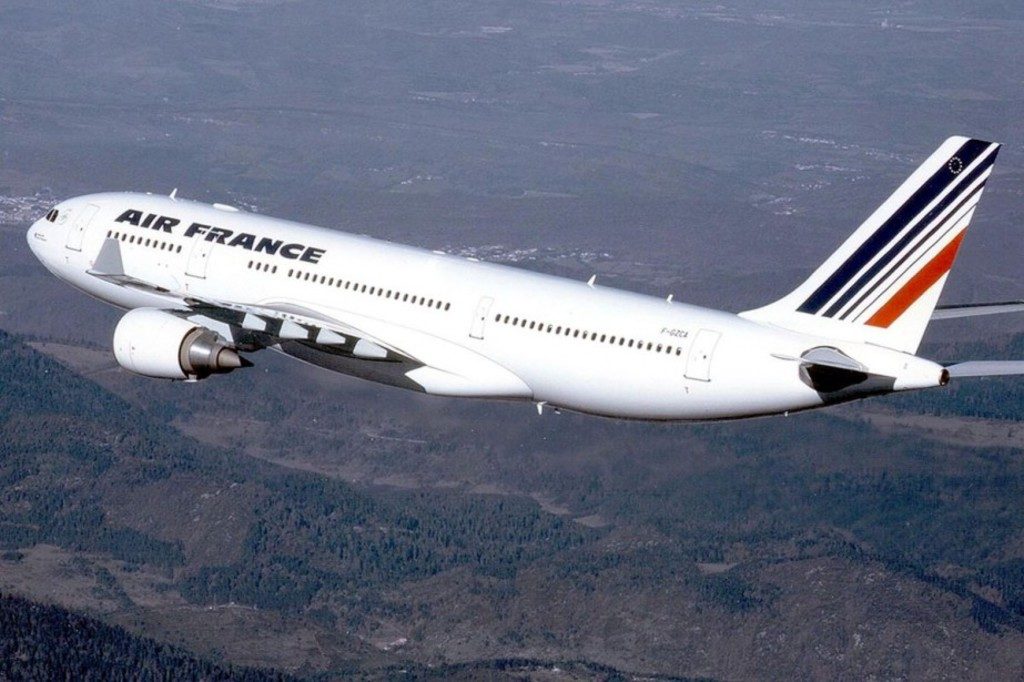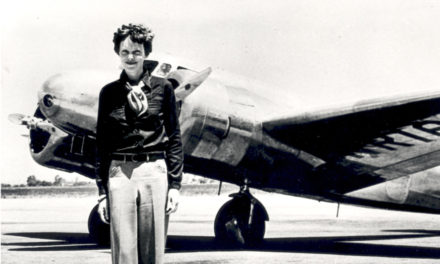Malaysian Flight 370
There have been plane crashes, and disappearing planes, since machines with wings first took flight, well over a century ago. But nothing, ever, has quite astounded, and confounded, like the disappearance of Malaysian Flight 370 on March 8, 2014. An enormous, state-of-the-art airliner, loaded with passengers and competent crew…taking a bizarre turn off-course, of over ninety degrees, ceasing radio communications, switching off tracking devices, flying off somewhere perhaps for hours, to places unknown, for reasons unknown.
For months upon months, no one could even be certain of Where the plane had flown, much less Why or How. Not a scrap of wreckage from the plane, not the slightest trace of any passenger, was found.
Parts of the plane may have finally surfaced, far astray in the Indian Ocean. Which may eventually answer the Where…but do little for the other questions that dominate the most amazing aircraft disappearance of all time, bar none.
THE PHENOMENON
Aircraft, vanishing, is hardly a new phenomenon. It’s as old as aviation itself, and if you drew up a list of the planes said to have vanished “into thin air,” or into thick ocean, utterly unaccounted for, well, you’d best have a lot of paper, a lot of ink.
Back in the Lindbergh and Earhart days, you waved goodbye in more ways than one to someone flying off over the water. There were a number of races for example, a dozen or so planes take off from San Francisco, bound for Hawaii, and let’s see who gets there first. More common than not in that scenario–a couple of planes never make it at all, and are never found or heard from. With the lesser communications and tracking systems of the day, even if you mounted an expensive search and rescue operation, you wouldn’t have known quite where to look.
And these famous disappearances, most from years ago, made blips on the radar screen of history. What happened to the celebrated French author and pilot Antoine du Saint Exupery, and what was the fate of the flight, over the English Channel, that carried famous band director Glenn Miller? Especially over water and sometimes even over land, planes often disappeared and were never accounted for.
But that was then, this is now. Commercial flights of recent decades are unbelievably safe by all statistical measures, which also means they’re incredibly predictable. The very occasional fight that still suffers catastrophic failure–think Air France Flight 447 bound for Paris that went down over the Atlantic in 2009–is dissected like a bug in a laboratory, or rather the reverse process, the pieces of evidence put back together to eventually explain the whole picture. The black boxes of that flight and similar disasters were recovered, sound theories constructed for system breakdowns, and usually corrective measures put into aviation practice.
There just isn’t much mystery, not anymore, in airplane crashes, especially not large, commercial-sized flights.
Until Mayalsian Airlines Flight 370 took off from Kuala Lampur for an overnight flight to Bejing, and on the morning of March 8th, 2014, it failed to arrive. Failed to send any confirmed Maydays (or any known communication indicating problems). Failed to stay on course, with no word from the cockpit about the changes. Failed to act predictably, or understandably, to aviation experts. Failed to crash or attempt a landing within the hour, as a distressed flight would be expected to do.
If routine satellite pings are any indication it flew on through the night. For hours, into nowhere, perhaps until fuel tanks were empty. And then entirely, utterly disappeared. Without a trace.
You could spend days, literally days, just watching reports or documentaries of varying length (and quality) regarding MH370’s bizarre disappearance, but this summary very early on, from the Canadian Broadcasting System and Adrienne Arsenault, offers the human texture, the setting, the known facts, all within a solid mindset. It’s worth the eleven minutes.
We’ll return later to the theory that a savvy pilot, needing to make very fast emergency decisions, might have turned sharply towards the landing strip at Pulau Langkawi, Western coast of the Malaysian peninsula, but then flew over it as the flight simply cruised at full altitude over the Indian Ocean until it’s fuel ran out.
The Mysterious Disappearance of this flight, in capital letters, rises as an astounding modern phenomenon–we simply haven’t seen it’s like, and may never again. The aircraft, a Boeing 777, has an excellent track record across a quarter century of long-range flight. Hundreds of millions of miles of safe flying in one of the most technologically modern, and most respected, of all craft in the fleets of the major carriers. Redundant safety and communication systems, leaving experts stunned–utterly baffled–at how thoroughly this flight not only went wrong, but went thoroughly missing.
To state the painfully obvious, something odd happened to MH370, some very anomalous cascade of events, a perfect storm of unusual circumstances.
But, what were those circumstances, and where (years later) is that dog-gone plane?
YEARS OF BEWILDERMENT
In a book from 2015, Richard Belzer and his co-authors review a mystery which has evolved a little, but surprisingly little in some ways, across several years. Some of the early comments still ring true to many analysts:
These authors refer to someone they respect who stressed, early on, “six important facts you’re not being told” about MH370.
Fact #3: Many parts of destroyed aircraft are naturally bouyant and will float in water.
Fact #4: If a missile destroyed Flight 370, the missile would have left a radar signature.
Fact#5: The location of the aircraft when it vanished is not a mystery.
Fact#6: If Flight 370 was hijacked, it would not have vanished from radar.
Conclusion: Flight 370 did not explode; it vanished…the inescapable conclusion is that Flight 370 simply vanished in some way that we do not yet understand.”
Belzer, Noory, and Wayne , 2015,”Someone is Hiding Something,” p.212
We don’t know if “someone is hiding something” (it’s entirely possible), or if any of those facts are secret, but we know this: several years in, we don’t know that much more than we did eleven days after, when the CBC broadcast the report we featured in the previous section.
 And that alone is astounding. We can’t think of a modern aviation disaster that’s generated fewer clear facts, yet generated myriad theories, in inverse proportion. If you had a dollar for each television report or mini-doc on this subject since March of 2014, you’d be wealthy by now.
And that alone is astounding. We can’t think of a modern aviation disaster that’s generated fewer clear facts, yet generated myriad theories, in inverse proportion. If you had a dollar for each television report or mini-doc on this subject since March of 2014, you’d be wealthy by now.
It’s a sort of pathetic cottage industry–go on cable television, look and sound important, and spout things you don’t know, because frankly no one does.
But in the midst of all that, there are some attemps, fact by fact, to reason deductively and make sense of unprecedented events. All the theory-making can at times serve a purpose.
In one of those mini-docs with over-the-top names starting with words like “the real truth behind”…nevertheless we’re reminded of the importance of looking at, and discarding theories one by one, over time, based on evidence.
“It may be confusing to see so many theories evolving about the loss of an aircraft and it’s a very technical issue, but all those theories are actually very useful, and it’s not ‘conspiracy theory’ but all of the side theories might put light on an unusual situation–so the forensic scientists who’ve got very open minds have to incorporate everything that’s coming up.” Dr. Sally Leivesley, Catastrophic Risk Advisor, from “The Real Truth Behind Malaysian Flight 370
But what do we know? In clear weather a superb aircraft suffered some sort of collapse of its normal functioning, yet leaving us with almost no clue. As another contributor to that same report reminds us, in a normal catastrophic failure the flight would have soon come down in pieces that we would have long since located. In most air disasters, the first photos the public sees are of the wreckage.
So what, then?
Two passengers travelled on MH370 on stolen passports, we’re told early on. A meaningful clue? Possibly, but…shifty people slink around the world all the time. The Titanic probably held a hundred people running from something, but not involved with the sinking of the ship. There’s no evidence those Iranians with false passports, or anyone else, hijacked the plane. If it was hijacked (not too likely) it was a botched or confused operation–no one ever claimed it, the plane probably did not survive or leave survivors. No purpose, no apparent motive.
Although intelligent life in our universe is probable, aliens involved in the MH370 disappearance is not. Only slightly more probable is the execution of a secret plan to spirit the plane deep into Asia for…for…why would that be again? What would be gained by bringing the plane down on remote Asian steppes, disappearing surviving passengers, and repainting a Boeing 777 that you’d can’t really hide, or use, or gain any benefit from. What’s the point?
And remember, it stretches the limits enough for the plane to have disappeared so thoroughly over water. Over land, with airports and radar scanning the sky at regular intervals? Not likely, unless “someone is hiding something,” although that would have to be a lot of someones, doing a lot of hiding. Yet we do have reason to wonder if some information has been suppressed, for whatever reason.
The captain, they tell us a couple of years later, had plugged unusual flight paths into his home-built flight simulator. Meaning what, exactly? We’ll also consider that specious news until something more solid can be made of it. Nonetheless, one of those flight paths supposedly aimed at the landing strip at the ultra-secret U.S. military base at Diego Garcia, south of the Indian subcontinent. Why would he be toying with that idea? And with the powerful U.S. intelligence presence surrounding that base, wouldn’t a flight astray over the Indian Ocean be noticed?
A cyber-hijacking? Perhaps more logical than many of the theories, it would explain why the flight went radio silent, changed course erratically, flew to nowhere for no seeming reason. A chilling throught: some of the world’s most talented cyber criminals may have just been experimenting, testing their skills for a really purposeful mission at a future time. Unlikely? Yes, but Dr. Leivesley, the same expert who challenged us to have “very open minds,” offers the possibility as real and worth exploring.
Little hints, morsels of potential evidence, scraps of theories, have been discussed for years now. Any shred of a clue’s soon pounced on by those hungry for answers. The mystery remains intact.
All that’s not to say that time hasn’t shed a little light, a very little, on the disappearance. When we said in the first section that MH370 vanished “without a trace,” well, over time, we think we have some traces.
 A flaperon, part of the wing assembly, and some other debris probably from the flight began showing up in, yes, the Indian Ocean, washing up on the surrounding shores.
A flaperon, part of the wing assembly, and some other debris probably from the flight began showing up in, yes, the Indian Ocean, washing up on the surrounding shores.
That flaperon, all by itself, has taken on a life of its own, and it does represent something tangible, and intriguing. We’ve even seen a mini-documentary where a man speaking in logical sequences offers a pointed assessment.
Look carefully at that flaperon, he says, and you’ll see something in very unusual shape. Not cracked into a hundred pieces. Rather seemingly sheared off along its outer edge, as if deployed in a downward position upon contact with the water, not a nose-first dive into water, but more an attempt at a controlled landing. Therefore, we know that a pilot attempted a water landing, the plane didn’t just crash into the brink out of control.
His theory depends on a chain of sequence and logic, but we have to admit, it does explain the condition of that large piece of aircraft. We do wonder however, if other crash scenarios could have produced that same piece, sheared off along its edge. If we go for attempted-landing-theory as logical, we’re faced with lots of questions. Why, how, would that plane fly that far, still under human control, still over water? Why try to land it on the ocean–that’s never, ever gone well in the history of aviation.
Could we be looking at a scenario in which a pilot, or some human agent, got control of the plane just in time to have to ditch on water, and took their best shot at it? Unlike that famous landing in the U.S. on the smooth Hudson River, with perfect weather and rescue boats within clear view, this would have been pointless, with everyone soon on their way to ocean’s bottom. So which presents more challenge, designing a scenario for a landing far out in the ocean, or a scenario in which that flaperon comes off in that unexpected shape?
In any event, our working hypothesis has to be that the plane did go down, as originally suspected, in some remote part of the Indian Ocean, hours after changing course.
But just how, why, did that flight deep into nowhere, over the water until fuel ran out, come about?
THE BEST THEORY
“Half a clue plus half a clue does not equal a whole clue, it equals nothing!” ~ As spoken by a veteran Italian trial judge, circa 2002
Theories abound, some of them almost plausible, some of them having little to offer, except desperate hope for an answer to the greatest aviation mystery of them all.
From air disaster expert David Soucie, who recognizes several possibilities, the theory he finds most plausible:
Pilot oxygen masks are designed to provide an airtight seal around the mouth, nose, and eyes…because of the airtight seal, sound could not escape the mask after it had been donned, the Captain was thus not able to communicate…with Air Traffic Control.
Realizing the severity of the situation, he elected to make an immediate turn toward the closest airport with adequate runway length…
The load shedding was unsuccessful in reducing the smoke in the cockpit, although it was successful in shedding the communications bus, including the transponder. In a desperate effort to quell the smoke, the pilot depressurized the aircraft. The lack of oxygen at 35,000 feet would most likely extinguish the fire…oxygen masks dropped in the cabin for passengers, (but plastic) lines are not resistant to high temperatures…depleting the cockpit crew’s oxygen supply within seconds.”
David Soucie, Malaysia Airlines Flight 370, p. 120-121
In this scenario, then, a fire triggered a cascading set of events that left the craft without oxygen at full altitude, with crew and passengers soon blacking out. The aircraft, after it’s turn now pointed out towards the Indian Ocean, would have flown for hours, and thousands of miles, before running out of fuel and going down in the middle of nowhere. And remember, along with the desperate measures that sacrificed pressurization, the electrical circuits that drove the transponder were shut off, giving the false appearance of a crew that wanted to go rogue.
 (It’s worth noting that the everyone-blacked-out-from-hypoxia theory has precedent, for example, flight ZU 522 operated by the Greek carrier Helios, on August 14, 2005. When the flight went radio silent fighters were scrambled, and a close fly-by observed crew slumped over their controls. One passenger had texted his cousin that “the pilot has turned blue,” and observers of the wreckage on the ground saw oxygen masks everywhere. We don’t think much about it because most flights keep the craft pressurized and oxygenated, but lack of oxygen kills, and quickly. This flight cruised on auto-pilot a couple of hours with an incapacitated crew, and finally crashed into rugged terrain, no survivors.)
(It’s worth noting that the everyone-blacked-out-from-hypoxia theory has precedent, for example, flight ZU 522 operated by the Greek carrier Helios, on August 14, 2005. When the flight went radio silent fighters were scrambled, and a close fly-by observed crew slumped over their controls. One passenger had texted his cousin that “the pilot has turned blue,” and observers of the wreckage on the ground saw oxygen masks everywhere. We don’t think much about it because most flights keep the craft pressurized and oxygenated, but lack of oxygen kills, and quickly. This flight cruised on auto-pilot a couple of hours with an incapacitated crew, and finally crashed into rugged terrain, no survivors.)
We at M.O. Mystery, as non-experts in the highly technical world of modern aviation, don’t know if this theory for MH370 is crippled by major flaws, but it has comprehensive answers. It would explain why the sudden transponder signal loss, communication loss, and route change occurred so quickly in sequence, and it would explain why the craft flew on forever, pilotless, a ghost ship of the skies. It would explain why a geo-stationery satellite seemed to pick up, hourly, the signal of that plane moving across that vast expanse. It would even explain the apparent ping or two from a cell phone in the early missing minutes, because Soucie theorizes further that one or more flight attendants could have breathed for a time from separate oxygen bottles outside the cockpit.
If one crew member was able to breathe longer than anyone else, just imagine the uncanny, otherworldly scene they hung on to. There they would have been, tethered to a fading oxygen source, in a plane sailing through thin air several miles high, at hundreds of miles an hour, astray in the night. If any light remained in the cabin, they would have seen every passenger unconscious, as if asleep, and realized they would never be awakening. He or she, the last temporary survivor of this lost airship, would have realized there was nothing, nothing whatever they could do, except keep drawing breath for a time. It must have been among the most hopeless, eerie feelings that any soul, in the sky or anywhere else, has ever felt.
……………
We’re tempted to fully go with the Soucie theory–so many electric buses were pulled so fast to combat a fire, that the plane appeared rogue when it was simply in unprecedented distress.
The theory has a certain elegance to it, complexity yet simplicity, the plane (with crew and passengers expired from lack of oxygen) ran out of fuel and went straight down in the remote Indian Ocean. Minimal debris at first, due to entering nose first. Story over.
We’re tempted to promote this theory as the best, sharpest Razor that Occam has on hand, but…we’re not so sure, not so sure it passes all the smell and logic tests. It may have more flaws than we’re comfortable with.
Item: Even with a sudden disaster–a fast moving fire let’s say–putting the two-man crew into frantic motion, there should have been moments for one or the other of them to Mayday! their distress to the ATC world. It’s standard, reflexive procedure. And, even if they donned their oxygen masks and found the microphones inside them disabled for some reason, there are supposedly several other methods to let ATC know when you’re managing an emergency. And some reports say there was a Mayday call to Vietnamese ATC, but that piece of news gets omitted from the reports filtered down through CNN and the like. Who to believe?
Item: We keep reading about the striking redundancy of communication and tracking systems, both in the aircraft and on land. From the Rolls-Royce engines to major mainframe components, electronic message sending was built into the system a score of different ways, we’re told. Some experts scoff at the idea that desperate closing of electrical circuits could have crippled all of those sources of information, more intel should have survived that process, they assert.
And that’s just the aircraft iself. We also read that by 2014, satellite surveillance systems as operated by the major powers were so sensitive that you could turn on your transistor radio on earth somewhere, and the satellite would register you. Exaggeration and hype? Perhaps, but we do get it when surveillance experts just don’t find it credible that a plane so massive and modern could escape detection, from so many radar/radio/satellite listening sources. And these sources should have had their “ears perked up,” if you will, to an extra degree after the plane disappeared form its normal Air Traffic Control connections.
Item: If the plane ditched in the Indian Ocean, any ocean, it should have left a dramatic pattern of debris on the surface of the water. Every open ocean ‘landing’ has been a disaster, and floating plane and luggage parts are spotted within hours, not years. Thus, still another striking anomaly with this plane disaster is a presumed ocean crash without ocean debris.
So at the end of the day, if the story was more complex than simple hypoxia and disabled pilots, what was it? Just what did happen to that plane?
We still ask the question after unprecedented years of not knowing.
THE STORYBOARD
The stories of families of victims.
The stories of journalists who covered the amazing saga in real time.
The stories of aviation experts who grappled with the possibilities.
We hope, in time, to offer many of these stories here.








